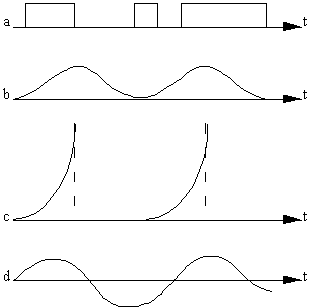We have not made any attempt to dispense with
the two fundamental experimental results (II) and (VI). However,
the compatibility of these results entails that not-existence
should be regarded as a certain existence, hence as something
outside what we empirically know to be existence. That something
cannot be just a logical or a philosophical operator, since orthoexistence
is a concept deduced from experimental premises, and according
to our whole scientific experience, we expect it to be subject
to experimental verification.
Given that the particular coordinates of orthoexistence
are not known, one could hardly try to decipher the dynamics of
orthoexistence. We can only model the general dynamics of existence,
taking orthoexistence into account. The immediate question is:
when space-time existence arises, what happens to orthoexistence
? Does it vanish or does it continue in a certain way ? Given
that space-time existence and orthoexistence are interchangeable
and are both material, it is just normal that they should satisfy
a general conservation principle:
XIII. L = E(space-time
existence) + H(orthoexistence)
= constant.
Here, we have obviously used our
scientific experience as applied to material processes. We do
not know the actual way in which the quantity "L" relates
to mass and energy - the main quantities of interest
in existence conservation processes - but it might be of the nature
of these quantities. If extrapolated to orthoexistence the conservation
principle raises the question of the meaning of quantity
H
as a function of what might be pertinent to orthoexistence. The
conservation principle does not apply to space-time existence.
Instead, it can apply to the world. It is only under certain
conditions and in a first approximation that
E(space-time existence) <>
constant. The space-time existence conservation processes are
no longer strict: existence might vanish, it might arise, and
hence develop between these two events.
By virtue of the conservation principle, the
world is a constant and existence may assume the evolution patterns
illustrated in Fig. 50 (a, b, c, d).

Fig. 50
In case (a) existence would arise and vanish
without exhibiting an evolution, whereas in case (b) it would
exhibit a certain rise-and-fall dynamics.
Other patterns may be also envisaged (seecases c and d).
In case (c), existence would spring from a nucleus
and expand to infinity to vanish at a given time. In case (d),
two types of existence - one positive and the other negative -
would be alternating. Referred to the general philosophical principle
expressed in the figure, the above diagrams suggest only one phenomenon,
namely the emergence and the cessation of existence.
Concerning the representation with respect
to time, which is an attribute of space-time existence, the time
laps between two existences is of no relevance. That is why the
time interval tcin Fig. 51 is meaningless.
Space-time existence emerges with time
proper and vanishes together with its own time. Space-time existence
vanishes together with its own space and emerges together with
its own space.

Fig. 51
Any space-time existence develops in its own
space and time. A certain space-time existence is alien to another
space-time existence. The time and the space associated to various
types of existence are incompatible among themselves.
Hence, any such existence originates with
time, which begins thus to "flow". The above diagrams
describe only one phenomenon, i.e. the emergence and the disappearance
of such an existence.
As concerns the representation with respect
to time, the time being an attribute of such an existence, the
time periods between two existences are of no significance. This
explains why the time interval tc
in Fig. 51 is meaningless. A space-time existence emerges with time
proper and vanishes with its own time. Such an existence vanishes
with its own space and emerges with its own space.
A space-time existence develops against its
own space and time. The times and the spaces of different such
existences are incompatible.
The Philosophical Experiment
88







